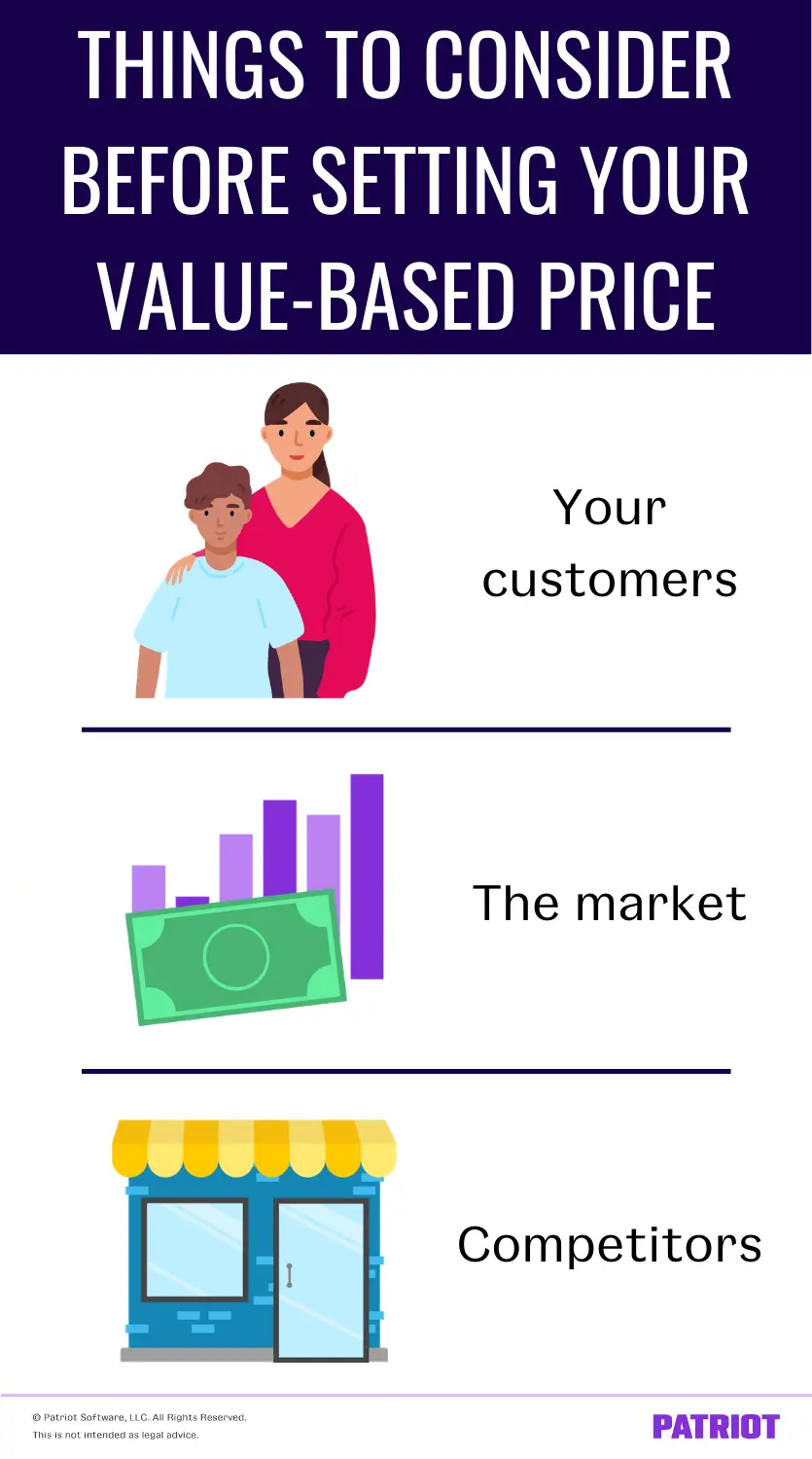There are a number of strategies you can use to price your products or services. One of them is value-based pricing. Read all about value-based pricing, its pros and cons, and how you can use it to strategically price goods and services at your small business.
What is value-based pricing?
Valued-based pricing, or customer-based pricing, is a strategy businesses use to charge products or services at a rate they believe customers are willing to pay. Instead of marking up items based on various costs (e.g., production costs), companies that use value pricing base their prices on their customers’ idea of how much a product or service is worth.
The value pricing strategy is not for every type of business. Businesses typically use value-based pricing in highly competitive and price-sensitive markets or when selling add-ons to other products. Companies that offer unique or highly valuable products and features are better positioned to take advantage of the value pricing model.
Some industries subject to value-based pricing models include:
- Fashion
- SaaS
- Cosmetics
- Technology
A value-based pricing model is the opposite of cost-plus pricing. Cost-plus pricing looks at cost of goods sold and markup percentage to determine a price. There are also a number of other pricing strategies to choose from (which we’ll get to later).
Benefits of a value-based pricing strategy
At this point, you may be wondering, Should I use customer value-based pricing at my small business? To answer that question, you need to know the advantages of the value-based pricing strategy.
Potentially higher price points
If customers are willing to pay higher prices for your offerings, you can start right off the bat at a higher price point. From there, you can continually add value to your products and/or services and make necessary adjustments to prices and increase your price points even more.
Perceived value can increase
Although your customers see a certain value in your offerings, you can shift your perceived value to make your products or services more profitable. Marketing your business’s offerings as elite, top-notch, high-quality, etc. can help position what you offer as more valuable. And the more perceived value your products or services have, the more massive your markups can be.
Helps you develop higher-quality products
When it comes to value-based pricing, value is everything. If customers don’t see value in your product or service, they aren’t going to be willing to pay the price for it.
Learning what your customers are willing to pay for your offerings can help you determine what you need to adjust to make your product or service better than ever (e.g., adding a new feature).
Value-based pricing can help you continue to progress your offerings, make tweaks, and improve them further. The more value you add, the more your customers will be willing to pay.
Downsides of value pricing
Sure, value-based pricing has its perks. But, it also has some downsides. Here are a few disadvantages of using value-based pricing at your small business:
- Harder to set a price than other strategies
- Requires more time and resources
- Lower markups
- Not 100% reliable
- Changes based on cultural, economic, and technological factors
Do your homework and weigh the cons before deciding to use value-based pricing at your company.
Value-based pricing example
To understand this pricing method a little better, let’s see value-based pricing in action.
Say a coffee shop, Company A, charges twice as much for a cup of coffee than their competitor, Company B. Although their prices are double what others charge for similar products, people are willing to pay more for coffee from Company A.
Why, you ask?
Company A has brand-loyal customers and superb peer-to-peer marketing. Because of this, they have a strong connection with their customers. They also market quality and value to consumers and make them feel they are buying the best of the best. Therefore, the customers are willing to pay the extra money for the perceived value and quality of the coffee.
Setting your value-based price
To set a value-based price for your products and/or services, you need to put in some legwork and do your research. Unlike other pricing strategies, there is no value-based pricing formula. Instead, there are a few things you have to consider before getting to your final selling price, such as:
- Your customers
- The market
- Competitors
Because your price point is solely based on what your customers are willing to pay, you need to figure out how much that exactly is. To do this, analyze your customers and find out how much they would spend on your product or service. You can conduct a survey or contact customers to find out how much they’d be willing to pay and what they value about your offerings.
Next up: the market. While customer data is important to set your value-based price point, you also need to look to the market to determine what potential customers would be willing to pay for your offerings. Conduct research in your market to find out how much customers would be willing to spend.
Finally, conduct a competitor analysis, especially if your product or service is new to the market. Look at your main competitors to find out how much their customers are willing to spend on offerings similar to yours. Setting your product to a similar price point can help you gauge how much your target market values your product or service.

More pricing strategies options
As a business owner, you’re not limited to just one type of pricing strategy. There are a plethora of other options out there. Additional pricing strategies you can utilize at your small business include:
- Cost-plus pricing
- Competitive pricing
- High-low pricing
- Bundle pricing
- Combination of pricing strategies
Like anything in business, do your research on the various pricing strategies before making a decision. Weigh the pros and cons of each method and find out which will work best for your business before you implement a strategy or a combination of multiple pricing strategies.
After you set prices for your products or services, you need a way to record your sales. Patriot’s online accounting software makes it easy to track income, record payments, create invoices, and more. Try it for free today!
This is not intended as legal advice; for more information, please click here.



